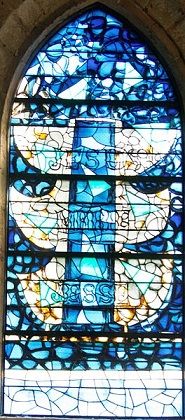Woman With a Guitar by George Braque Is What Art Movement
Georges Braque was at the forefront of the revolutionary art motility of Cubism. Braque's work throughout his life focused on still lifes and means of viewing objects from various perspectives through color, line, and texture. While his collaboration with Pablo Picasso and their Cubist works are best known, Braque had a long painting career that continued well beyond that flow.
Biography of Georges Braque
Babyhood
Georges Braque was guided from a young age toward artistic painting techniques. His male parent managed a decorative painting business and Braque's interest in texture and tactility perhaps came from working with him as a decorator. In 1899, at age seventeen, Braque moved from Argenteuil into Paris, accompanied by friends Othon Friesz and Raoul Dufy.
Early on Preparation
Braque'due south earliest paintings were made in the Fauvist style. From 1902-1905, after giving up piece of work as a decorator to pursue painting total-fourth dimension he pursued Fauvist ideas and coordinated with Henri Matisse. He contributed his colorful Fauvist paintings to his beginning exhibition at the Salon des Independants in 1906. However, he was extremely affected by a visit to Pablo Picasso's studio in 1907, to see Picasso's breakthrough work - Les Demoiselles d'Avignon. Later this encounter, the two artists forged an intimate friendship and artistic camaraderie. "We would get together every single day," Braque said, "to discuss and assay the ideas that were forming, equally well as to compare our respective works". The drastic change in Braque'due south painting mode can be direct attributed to Picasso. Once he understood Picasso'south goals, Braque aimed to strengthen "the constructive elements in his works while foregoing the expressive excesses of Fauvism". His landscape paintings in which scenes were distilled into basic shapes and colors inspired French art critic, Louis Vauxcelles, to coin the term Cubism by describing Braque's work equally "bizarreries cubiques." During this pre-state of war, highly-producive time, Braque (with Picasso) made large contributions to modern art, peculiarly through their exploration of Cubism - through the so-called Analytic and Synthetic phases of the motility.
Mature Period
Braque and Picasso worked in synchronicity until Braque'southward render from state of war in 1914. When Picasso began to pigment figuratively (joining what is known as Interwar Classicism), Braque felt his friend had betrayed their Cubist systems and rules, and continued on his own. However, he connected to remain influenced by Picasso'south work, especially in regards to papier collés, a collage technique pioneered by both artists using only pasted paper. His collages featured geometric shapes interrupted by musical instruments, grapes, or furniture. These were so three-dimensional that they are considered important in the development of Cubist sculpture. By 1918, Braque felt he had sufficiently explored papier collés, and returned to yet life painting.
Viewers noted a more limited palette at Braque's first post-war solo show in 1919. Withal he steadfastly adhered to Cubist rules about depicting objects from multi-faceted perspectives in geometrically patterned means. In this, he continued as a true Cubist longer than did Picasso, whose style, subject matter and palettes changed continuously. Braque was most interested in showing how objects look when viewed over time in different temporal spaces and pictorial planes. As a result of his dedication to depicting infinite in diverse ways, he naturally gravitated towards designing sets and costumes for theater and ballet performances, doing this throughout the 1920s.
Late Years and Death

In 1929, Braque took upwards landscape painting once over again, using new, bright colors influenced by Picasso and Matisse. Then in the 1930s, Braque began to portray Greek heroes and deities, though he claimed the subjects were stripped of their symbolism and ought to exist viewed through a purely formal lens. He called these works exercises in calligraphy, mayhap considering they were non strictly near figures simply more about sheer line and shape. In the latter one-half of the 1930s, Braque embarked on painting his Vanitas series, through which he existentially considered decease and suffering. Growing increasingly obsessed with the physicality of his paintings, he explored the means in which brushstrokes and paint qualities could enhance his subject matter.
The objects used in his still lifes were highly personal to Braque, however, he did non reveal these meanings. Skulls, for case, were objects he painted repeatedly at the onset of Earth War II. In 1944, when World State of war 2 ended, Braque began to embrace lighter subjects like flowers, billiard tables, and garden chairs. His last series of eight canvases made from 1948-1955, each titled Atelier, or Studio, depicted imagery that represented the artist'southward inner thoughts on each object rather than clues to the outside earth. At the very terminate of his life, Braque painted birds repeatedly, every bit the perfect symbol of his obsession with space and move.
The Legacy of Georges Braque

Braque is remembered every bit a progenitor of Cubism, who was both rational and sensuous in his still life paintings. He was a classic painter in this sense, and has influenced the likes of Jim Dine and Wayne Thiebaud, who focused on still life painting. Braque is besides a celebrated colorist, and tin can be traced through contemporary art to those painters who work with color in similar ways. Perhaps Braque is about remembered for his use of collage, as many contemporary artists, from sculptors like Jessica Stockholder to painters like Marking Bradford, utilise newspaper to their works every bit a means to comment on society and its products.
Source: https://www.theartstory.org/artist/braque-georges/
0 Response to "Woman With a Guitar by George Braque Is What Art Movement"
إرسال تعليق